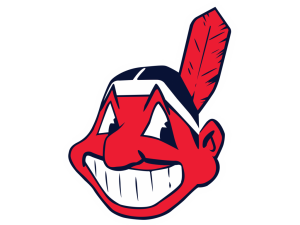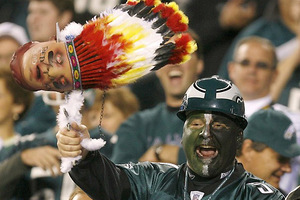DANIEL STYLER
<Staff Writer>
During my early elementary school days, my wardrobe almost exclusively consisted of sports-related clothing. I was completely indiscriminate when it came to the team depicted on my T-shirts, sweaters, jackets, and hats, so long as I thought that what I was wearing looked cool. Teams that I had no allegiance to or interest in were well-represented in my dresser drawer, all in the name of ten-year-old Daniel’s idea of high fashion.
 I was quite fond of Cleveland Indians apparel. In particular, ten-year-old me loved the over-the-top caricature of an Indian (the team’s choice of words, not mine) depicted on their hats and jerseys. This wasn’t just any Indian, either. This was Chief Wahoo, the cartoonish, very red-faced, headdress-wearing American Indian with the triangle-shaped eyes, wide smile, and bright white teeth.
I was quite fond of Cleveland Indians apparel. In particular, ten-year-old me loved the over-the-top caricature of an Indian (the team’s choice of words, not mine) depicted on their hats and jerseys. This wasn’t just any Indian, either. This was Chief Wahoo, the cartoonish, very red-faced, headdress-wearing American Indian with the triangle-shaped eyes, wide smile, and bright white teeth.
Twenty-six-year-old me thinks this is a problem, and this problem was articulated in a recent Cleveland Scene article by Sam Allard: Chief Wahoo is “an aggressively racist symbol, and it’s mortifying if you take thirty seconds to look at the image, or think about it in a human context, or any context other than, you know, a ‘logo.’”
Chief Wahoo isn’t just a harmless caricature drawn by a street artist depicting some nameless kid skateboarding or playing guitar; it’s a caricature that has the effect of portraying an entire race of people in the least dignified way imaginable. Despite innumerable protests – including annual Opening Day protests held in Cleveland – against the use of the Chief Wahoo logo, he is still featured prominently on every uniform the Cleveland Indians wear.
Earlier this year, Cleveland Indians president Mark Shapiro, echoing earlier statements by the team’s owner, stated the following: “Chief Wahoo’s not going anywhere” and the Indians’ team name is “recognition of our pride and affiliation with the first Native American baseball player.”

Louis Sockalexis, a Native American, did indeed play parts of three seasons with the Cleveland Indians in the late 1890s, and is often credited (though not universally so) as being the first person of Native American ancestry to play Major League Baseball. Using Sockalexis as continued justification for Chief Wahoo, though, appears to be nothing more than an example of a bad (and overly convenient) case of revisionist history.
Sockalexis played fewer than 100 games for the team, dealt with racism and taunting throughout his short-lived career, and was an alcoholic (he once injured his ankle after jumping from the second-story window of a brothel in a state of drunkenness). Joe Posnanski, one of the most distinguished and well-respected sportswriters of this generation, asks the following: “Why exactly would people in Cleveland – this in a time when Native Americans were generally viewed as subhuman in America – name their team after a relatively minor and certainly troubled outfielder?”
The Cleveland Indians may be the most egregious offender when it comes to offensive logos in professional sports, but they are certainly not alone.Even if Bob DiBiasio, the team’s VP of Public Relations, is sincere when he insists that Wahoo is a means to “acknowledge and foster the legacy of” Sockalexis, fostering the legacy of someone via racial caricature is a bit perplexing. It seems to be the Aboriginal equivalent of the Los Angeles Dodgers honouring Jackie Robinson, the first African American to play Major League Baseball, by replacing the iconic interlocking LA logo on their hats with a depiction of Little Black Sambo and his dark, dark skin, excessively white eyes, and exaggerated bright red lips (he could be holding a baseball bat for good measure).
The Washington Redskins, for instance, are currently enduring controversy over the team’s name. Two of the most prominent sportswriters in America, Bill Simmons and Peter King, are both boycotting the use of the nickname Redskins (with Simmons calling them the Washington D.C.’s in a recent article). This is not particularly surprising, as it is difficult to see how the term Redskins can be said without evoking negative race-based connotations. Oh, and when you name sports teams after racial groups, things like this happen:
I do not consider myself to be some sort of politically correct zealot, and often find myself rolling my eyes at some of the things people find offensive. But it is discouraging when, in 2013, we are still talking about why it is wrong to disparage a historically underprivileged and marginalized race of people (and to make money via merchandise sales while doing so).
